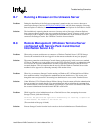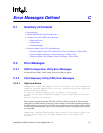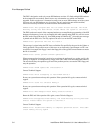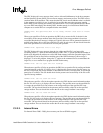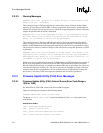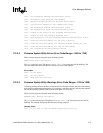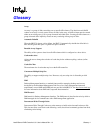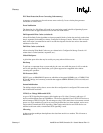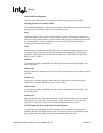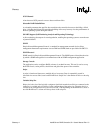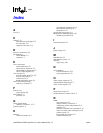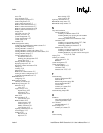
Intel® Server RAID Controller U3-1 User’s Manual Rev 1.0 Glossary-1
Glossary
Array
An array is a group of disks containing one or more RAID volumes. The data from each RAID
volume on an array is evenly spread across all disks in the array. A RAID volume must be created
either on an existing array or on a group of unused individual disks. Creating a RAID volume on a
group of unused disks implicitly creates an array consisting of that group of disks.
Automatic Rebuild
When the SRCU31 detects a drive failure, the SRCU31 automatically rebuilds the failed drive's
data onto the global hot spare if a global hot spare is defined.
Bootable Array Support
The ability of the system to boot from a RAID volume which is configured as a boot device.
Cache mode select
Allows the user to change the selection of cache they desire without requiring a reboot (online
changes).
CacheSizeMax
The maximum size of cache that may be on the RAID controller.
Concurrent Multiple Strip Size
The ability to support multiple strip sizes. However, only one stripe size is allowable per disk
group.
DMI
Desktop Management Interface, a standard framework for managing desktops and servers,
developed by the Distributed Management Task Force, Inc. Since management framework
requirements can use DMI and SNMP, both are provided with SRCU31. See http://www.dmtf.org/
for more information about DMI and Component Instrumentation.
DMI Protocol
DMI stands for Desktop Management Interface. The DMI protocol describes the rules by which a
DMI-managed device communicates with a DMI management application.
Downstream Write Through Cache
Downstream Write Through Cache uses cache memory to buffer write data until written to disk.
This does not allow a read from cache following a write, but all read commands get data from disk,
eliminating cache lookup.



